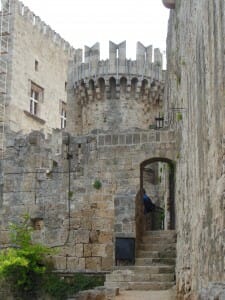
Rhodes is the largest island in the Dodecanese. It is a popular stop for Mediterranean cruises because it is crossroads of two major sea routes- the Aegean Sea and the coast of the Middle East. Since it is considered the meeting point of three continents, its history is influenced by several different cultures. As we strolled through the medieval city of Rhodes, a World Heritage Site, we viewed architecture that was affected by outside cultures. It was as if we had been transported back to the Middle Ages. We walked through dried out moats and entered through massive gates. During our brief cruise stop, we were determined to look for traces of Jewish Rhodes.
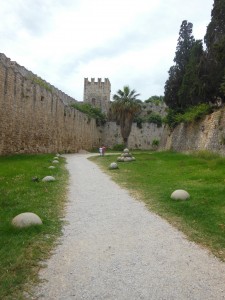
Overview of Rhode Jewish History
Historians are able to date a Jewish presence in Rhodes back to the second century BCE. This early history is limited to a few brief references. More information is found in the 12th century writings of Benjamin Tudela of Spain. These Rhode’s Jews did not follow Ashkenazi of Sephardic practices. Instead they used Greek in their services and adhered to Romaniote rites. During the Byzantine Period, Rhodes was occupied by different rulers- Persians, Saracens, Muawiyah, Seljuk Turks, and Genoese.
The knights of the St. John Hospitallers built the impressive walled fortress of the Old City during the Middle Ages. In the beginning of the 16th century, the Grand Master d’Aubusson expelled all of the Jews who refused to convert to Christianity. A few decades later, the Ottomans gained control of Rhodes and forced the Knights to leave. Suleiman the Magnificent welcomed Sephardic Jews back to Rhodes. These Jews spoke Ladino.
In 1912, the Fascist government of Italy defeated the Ottomans and occupied the islands of Dodecanese. Rhodes was the capital. The enactment and enforcement of racial laws caused many Jews to relocate. Despite these restrictions, the Rhodes Jewish community continued to grow and reached its height with a population of approximately 4,500 in the 1930s.
The Jewish Quarter housed four synagogues and had a nearby cemetery just outside the Koskinou Gate (Gate of Saint John). The anti Jewish Italian government in 1938 forced the Jewish community to move the cemetery by horse and buggy to a new location. The burial stones represented both the Romaniote and Sephardic cultures and some showed evidence of Ottoman influences. Approximately 100 gravestones were confiscated and used by the government to build a palace. In 1943, the German army took control of Rhodes. Almost the entire Jewish community was deported to Auschwitz. A little more than 150 Jews survived.
The armistice agreement called for British control during the transitional period. In 1947, Rhodes became part of Greece.
World War II bombings and other changes in modern Rhodes destroyed most of the landmarks of the Jewish Quarter. A Guidebook to the Jewish Quarter of Rhodes, by Aron Hasson as well as the museum’s website outlines a short walking tour that designates a limited number of landmarks. Evidence of prior Jewish life is reserved mostly to small plaques and street signs.
A visit to the Kahal Shalom Synagogue and the Jewish Museum of Rhodes will provide a more comprehensive overview, especially if one has a limited amount of time. The Jewish cemetery is located a mile away from the Old City on the road to Kalitheas. The cemetery has tombstones dating back to the 1500s, tombs of rabbis, and a Holocaust memorial.
Today only a handful of Jews live in Rhodes.
If you are looking for Rhodes Jewish history, it is best to start with two websites- the Kahal Shalom Synagogue and the Rhodes Jewish Museum.
Kahal (Kadosh) Shalom Synagogue or Kehilla Shalom
The synagogue is a short walk from the cruise ship port. It is located on Calle de Kahal Shalom (Dossiadou and Simiou Streets). The original structure dates back to 1577. It is the only synagogue that is still be used for services on the island.
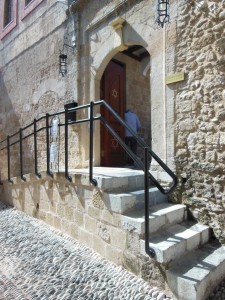
Kahal Shalom Synagogue
The entrance to the synagogue could easily be missed.
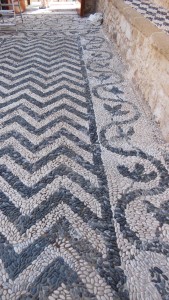
Kahal Shalom Synagogue
Inside is a courtyard with a noteworthy floor that is decorated with a traditionally designed stone mosaic pattern.
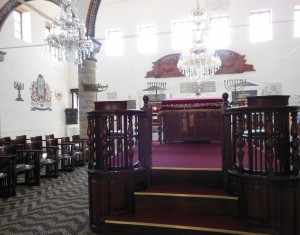
The sanctuary represents a traditional Sephardic style with the prayer table in the center. It faces southeast toward Jerusalem. I continually stopped to admire the floor.
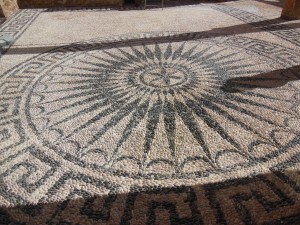

I wandered back to the center of the sanctuary to gaze at the wooden prayer reading table.
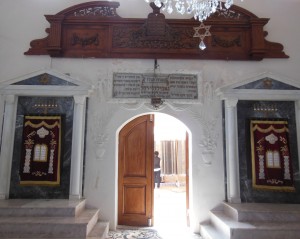
The walls were decorated with plaques and religious paintings. Few synagogues anywhere in the world have religious paintings.
Rhodes Jewish Museum
After visiting the synagogue, we walked into the adjacent museum that was established in 1997. Archaeologists believe that the 6 rooms used for the museum were originally built by the Knights of Rhodes to store grain during the 15th century. The Kahal Shalom Synagogue converted these areas to a women’s prayer area.In the 20th century, the women worshippers were relocated to a new balcony above the sanctuary.
The museum includes a selection of artifacts and still photos.
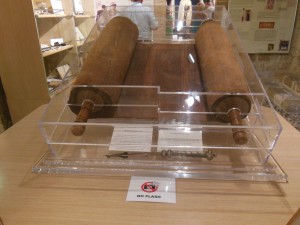
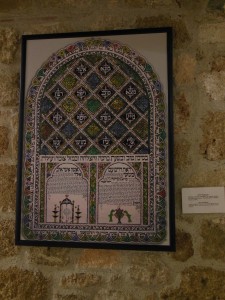
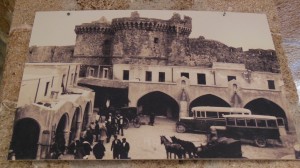
1920s view of main market square
in the Jewish Quarter
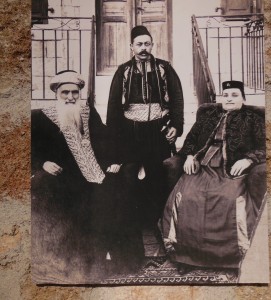

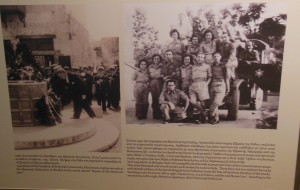
From Rhodes
The picture of the left shows the 1946 wreath laying at the Square For the Martyred Jews. The one on the right is of 6 Rhodesli Jewish Holocaust survivors in Italy with members of the Jewish Brigade.
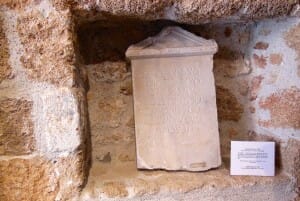
16th Century
Rhodes Holocaust Memorial
Not far from the Kahal Shalom Synagogue and the museum, we walked to a small park at the end of La Calle Ancha. This area used to be filled with Jewish homes. Bombings during World War II leveled all of the structures. A park was created afterwards. A Holocaust Memorial was dedicated in 2002. Each of the six sides is written in a different language- Greek, Hebrew, English, French, Italian, and Ladino (Judeo-Spanish). The inscription reads: “In Eternal Memory of the 1604 Jewish Martyrs of Rhodes and Cos Who Were Murdered in Nazi Death Camps. July 23,1944.”

Our time was limited so we were unable to take the walking tour or visit the cemetery. In retrospect, I wish that we would have allotted more time to look for Jewish Rhodes. If you are traveling to Rhodes, visit the Rhodes Jewish Museum and the Kahal Shalom websites. Visiting these historical sites in person or online will assure that the Jews of Rhodes are not forgotten.
Related Blogs:
Looking For Greek Jewish History
A Step Back in Time- The Jewish Catacombs in Rome
Hamat Teverya National Park- An Historical Gem in the Galilee
Bet She’arim- Important Necropolis from Talmud Era
Jew Town and the Paradesi Synagogue
Bio
Sandra Bornstein is the author of MAY THIS BE THE BEST YEAR OF YOUR LIFE. It is available on Amazon.
Sandra’s memoir highlights her living and teaching adventure in Bangalore, India. She is a licensed Colorado teacher who has taught K-12 students in the United States and abroad as well as college level courses. Sandra is married and has four adult sons.
The memoir was a finalist in the Travel category for the 2013 Next Generation Indie Book Awards, the 2013 International Book Awards, the 2013 National Indie Book Excellence Awards, 2013 USA Best Book Awards, and a Honorable Mention award in the Multicultural Non-Fiction category for the 2013 Global ebook Awards.
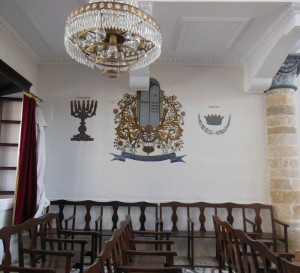
Leave a Reply
You must be logged in to post a comment.